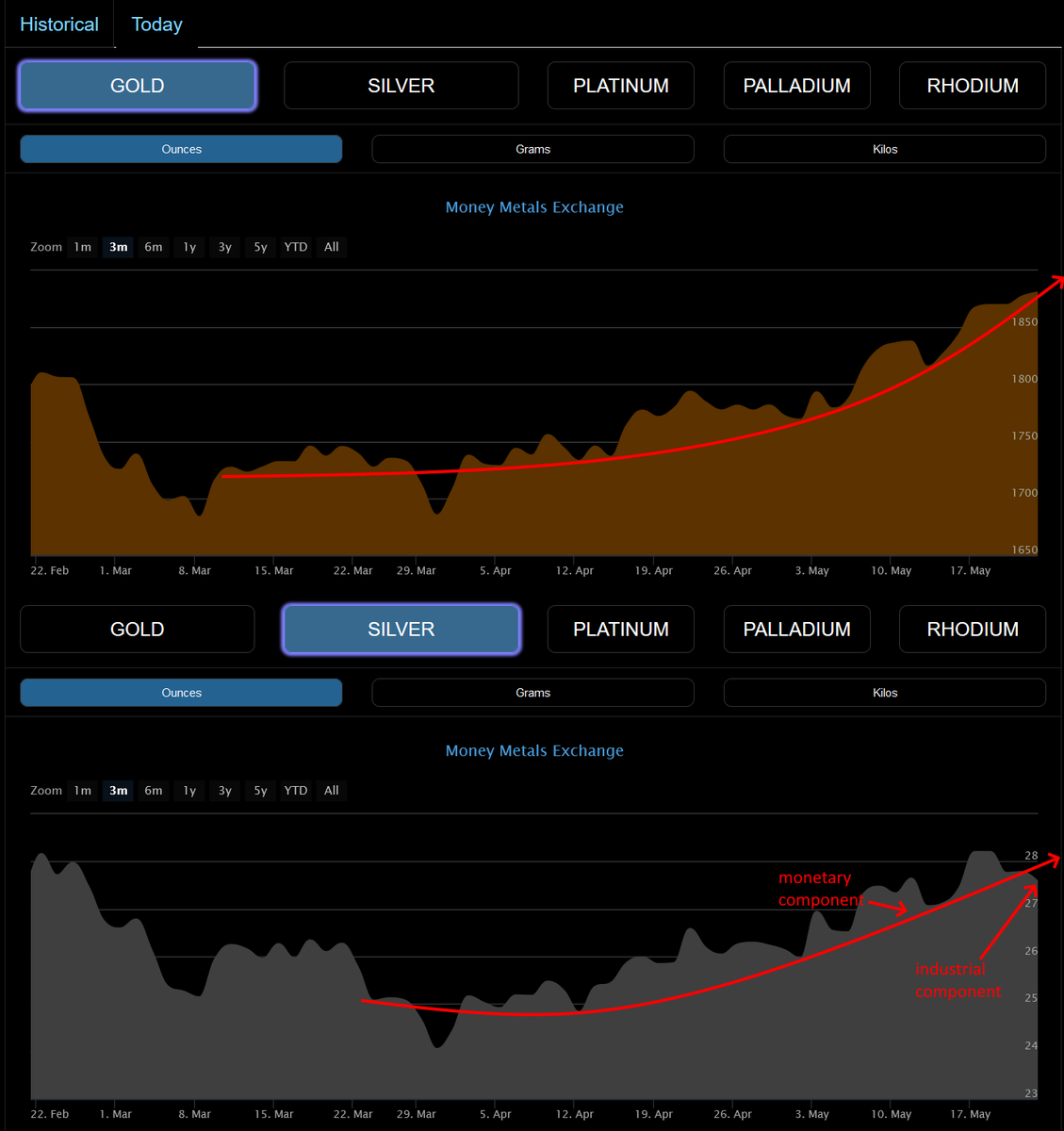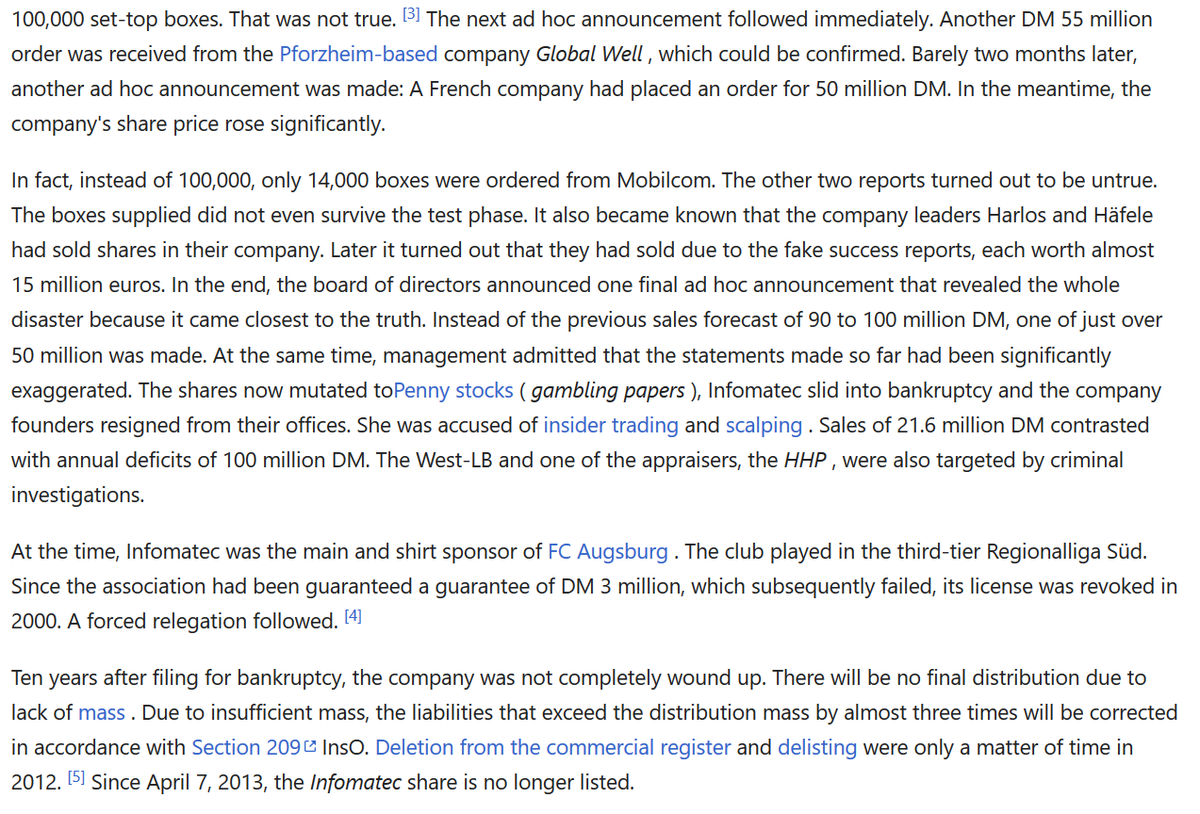
Shouldn't have touched my friend.
Don't listen to somebody who runs a literal ponzi AND pyramid scheme @goldsilver_pros. Thanks for posting a rebuttal page Richard that makes it easy.
Let's run through #HEX shall we? 👇
First off, you need a bit of humility. 30 =/= 8.5 (or 28)
Don't listen to somebody who runs a literal ponzi AND pyramid scheme @goldsilver_pros. Thanks for posting a rebuttal page Richard that makes it easy.
Let's run through #HEX shall we? 👇
First off, you need a bit of humility. 30 =/= 8.5 (or 28)
https://twitter.com/RichardHeartWin/status/1395823519674548224

From your own page.
- You ADMIT HEX is backed *by air*. "Whatever" is a very large range, and that includes Zero.
- Your argument against Bitcoin being a scam is "people own it". People are easily fooled.
- Ethereum isn't a scam, but there's no calls on its longevity either.
- You ADMIT HEX is backed *by air*. "Whatever" is a very large range, and that includes Zero.
- Your argument against Bitcoin being a scam is "people own it". People are easily fooled.
- Ethereum isn't a scam, but there's no calls on its longevity either.

Finally the bottom one. There is a KEY difference that makes Bitcoin and HEX substantially different:
The process of mining costs labor/resources. Simply locking up cash, doesn't.
"Anybody wanna pay me dollars for funny money? i'll give you more funny money later!"
The process of mining costs labor/resources. Simply locking up cash, doesn't.
"Anybody wanna pay me dollars for funny money? i'll give you more funny money later!"
On the topic of inflation:
You're right that inflation is an increase in the money supply. But - this comes at *the cost of everybody already holding the coin*!
Meaning - You're *actively devaluing EVERYONE* to the tune of 3,69% a year (nice).
*and that's LITERALLY all!*
You're right that inflation is an increase in the money supply. But - this comes at *the cost of everybody already holding the coin*!
Meaning - You're *actively devaluing EVERYONE* to the tune of 3,69% a year (nice).
*and that's LITERALLY all!*

I understand the mechanism. Doesn't mean anything if the coin *itself* doesn't have any value.
And you admit it doesn't. It's backed by "whatever people are willing to pay for it".
I wouldn't pay for it. Which is an option.
Oh and.. "Daily compounding" =/= yearly.
And you admit it doesn't. It's backed by "whatever people are willing to pay for it".
I wouldn't pay for it. Which is an option.
Oh and.. "Daily compounding" =/= yearly.
Finally, from your own site again.
Pyramid scheme: Wrong. It doesn't "rely on middlemen", it relies on layers, where the top layer benefits from the bottom layers WITHOUT offering a product of value.
You're benefiting from them alright (i'll get to that later).
Pyramid scheme: Wrong. It doesn't "rely on middlemen", it relies on layers, where the top layer benefits from the bottom layers WITHOUT offering a product of value.
You're benefiting from them alright (i'll get to that later).

"the network effect" can be said to be a pyramid scheme, if money were to be involved.
As for a bubble, Nothing isn't worth 30 billion for sure.
As for Ponzi, correct! It does lure in new investors with outsized returns!
Where are YOU gonna get 40% with 3,69% fixed inflation?

As for a bubble, Nothing isn't worth 30 billion for sure.
As for Ponzi, correct! It does lure in new investors with outsized returns!
Where are YOU gonna get 40% with 3,69% fixed inflation?


Cause that's quite the conundrum.
Either inflation is fixed at 3,69% - and you will ALWAYS get a yearly 3,69% return no matter what - OR the return is higher, because inflation is higher.
Because that's literally all you have. A token backed by air. It's pure supply/demand.
Either inflation is fixed at 3,69% - and you will ALWAYS get a yearly 3,69% return no matter what - OR the return is higher, because inflation is higher.
Because that's literally all you have. A token backed by air. It's pure supply/demand.
More tokens more inflation, less tokens less inflation.
So i read about people converting Ethereum into HEX.
*that's inflation*. Money supply of HEX goes up - means more inflation.
Locking it away was a smart move on your part. Doesn't impact liquidity that way. Doesn't "hit"
So i read about people converting Ethereum into HEX.
*that's inflation*. Money supply of HEX goes up - means more inflation.
Locking it away was a smart move on your part. Doesn't impact liquidity that way. Doesn't "hit"

3,69% permanent inflation ALWAYS means 3,69% inflation.
....but what happens to the ETH that gets transformed?
HEX isn't mined. *AT ALL*. Literally, you lock up your HEX, and after the time period, you get more back.
....but what happens to the ETH that gets transformed?
HEX isn't mined. *AT ALL*. Literally, you lock up your HEX, and after the time period, you get more back.

...So what happens to the Ether then? Why does it require Ether at all?
I'll tell you why. *because there's nothing there*.
It's literally a number, ontop of Ethereum, that increases with time.
There's no added value *at all*.
What's the added value over DOGE?
I'll tell you why. *because there's nothing there*.
It's literally a number, ontop of Ethereum, that increases with time.
There's no added value *at all*.
What's the added value over DOGE?
I'm dead serious about that.
Etherscan and coingecko say there are 572 billion tokens worth $28B
....somewhat more then CMC's, CoinCodex's and Trading view's listed 173 billion, but i digress....
Roughtly, 3,69% of 572B is 21.11 billion.
DOGE will print 5 billion each year.
Etherscan and coingecko say there are 572 billion tokens worth $28B
....somewhat more then CMC's, CoinCodex's and Trading view's listed 173 billion, but i digress....
Roughtly, 3,69% of 572B is 21.11 billion.
DOGE will print 5 billion each year.
This year that's about 3,86% inflation. Next year, it'll drop below HEX - Yet it has no supply limit, so no liquidity problems either. Value wise, Doge will go up more.
And HEX still needs Ethereum. Which is PoS, btw, and HEX is PoS too, so the "hybrid PoW" claim is bullshit.
And HEX still needs Ethereum. Which is PoS, btw, and HEX is PoS too, so the "hybrid PoW" claim is bullshit.
So. How do you offer "upto" 40% returns when your entire coin is centered around 3,69% inflation?
Simple, you don't run ONE ponzi scheme!
YOU RUN A RESETTING PONZI SCHEME!
Naturally you get more if you lock away for longer right?
...Means you get less for locking away less.
Simple, you don't run ONE ponzi scheme!
YOU RUN A RESETTING PONZI SCHEME!
Naturally you get more if you lock away for longer right?
...Means you get less for locking away less.

Basically, the more people that join in on the scam the faster, the more THEY devalue EVERYONE ELSE - and get a bigger payday at the end.
And every time you see those above peak drops are effectively hyperinflationary events.
And i can tell you why nobody's noticed so far.
And every time you see those above peak drops are effectively hyperinflationary events.
And i can tell you why nobody's noticed so far.
Because outsized returns always work!
Think about it. HEX requires you to lock up HEX to get more HEX later. If that worked once - Why not twice? Why not three times?
That's a defining characteristic of a ponzi scheme yknow. People are incentivized not to pull the money out.
Think about it. HEX requires you to lock up HEX to get more HEX later. If that worked once - Why not twice? Why not three times?
That's a defining characteristic of a ponzi scheme yknow. People are incentivized not to pull the money out.
As long as the money is locked up, inflation doesn't hit.
Meanwhile, The people who AREN'T devalued are the ones who get in first.
*At some point* everybody who locks up is STILL devalued. And everybody who isn't loses ALOT more then 3,69% when that money moves.
Meanwhile, The people who AREN'T devalued are the ones who get in first.
*At some point* everybody who locks up is STILL devalued. And everybody who isn't loses ALOT more then 3,69% when that money moves.
And it's a pyramid scheme ontop of that, because... GUESS WHAT!
YOU CAN "TRANSFORM" ETHER INTO HEX!
BUT YOU CANNOT TRANSFORM HEX INTO ETHER!
Ya gotta sell it on DeFi *for* Ether.
SO WHERE DOES THE ETHER GO?
Is it *all* used up in transactions?
Or is Richard collecting them?
YOU CAN "TRANSFORM" ETHER INTO HEX!
BUT YOU CANNOT TRANSFORM HEX INTO ETHER!
Ya gotta sell it on DeFi *for* Ether.
SO WHERE DOES THE ETHER GO?
Is it *all* used up in transactions?
Or is Richard collecting them?
How *does* HEX pay its developers?
...which it doesn't need cause it's a basic Ethereum smart contract....
Well guess what? Richard can't print Ethereum. That has to be mined still.
But what he *can* print, is a coin worth whatever Ethereum people pay for it!!!
...which it doesn't need cause it's a basic Ethereum smart contract....
Well guess what? Richard can't print Ethereum. That has to be mined still.
But what he *can* print, is a coin worth whatever Ethereum people pay for it!!!
AND EVEN PUBLICLY ADMIT TO IT! MAKE IT PART OF THE BUSINESS MODEL!
You've got some cojones i'll give you that.
There's no value in #HEX. No value whatsoever. Regardless of what Bitcoin and Ethereum offer in value, HEX offers none.
Value isn't a statement. It's fundamental.
You've got some cojones i'll give you that.
There's no value in #HEX. No value whatsoever. Regardless of what Bitcoin and Ethereum offer in value, HEX offers none.
Value isn't a statement. It's fundamental.
Simply time isn't enough. Infact, time is deprecatory. Ideally, we'd not have things age at all!
Utility value is what you need. And HEX offers ZERO utility value ontop of Ether. Zero. Absolutely does NOTHING Ethereum can't do.
Except for Richard. Did well for him.
Utility value is what you need. And HEX offers ZERO utility value ontop of Ether. Zero. Absolutely does NOTHING Ethereum can't do.
Except for Richard. Did well for him.
But guess what?
The first one in on a Ponzi? Thats the creator.
Enjoy your time in the spotlight! Did i mention @goldsilver_pros is a former auditor who, upon learning all this, will probably shred you? Maybe even report!
#Bitcoin $BTC #BTC #HEX $HEX #Crypto #Ponzi #Fintwit
The first one in on a Ponzi? Thats the creator.
Enjoy your time in the spotlight! Did i mention @goldsilver_pros is a former auditor who, upon learning all this, will probably shred you? Maybe even report!
#Bitcoin $BTC #BTC #HEX $HEX #Crypto #Ponzi #Fintwit
• • •
Missing some Tweet in this thread? You can try to
force a refresh













